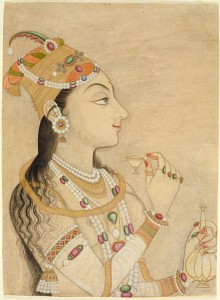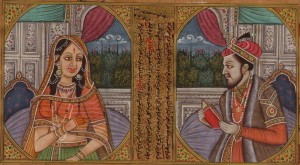
Long before a real life romance inspired the building of the Taj Mahal, India saw another real life romance play out in the royal family. The love story between Nur Jahan and Jahangir led to the expansion of the Mughal Empire, religious freedoms, and increased rights for women. It’s the story of a kickass woman and a man who liked her that way.
Nur Jahan was born with the name Mohr-un-Nissa in what is now Afghanistan in 1577. She was born to a prestigious family who lost almost everything and left for India, where they arrived penniless (along the way, robbers stole the little they still had). The family made it as far as Kahandar, where Mehr-un-Nissa was born and Mehr-un-Nissa father, Mirza Ghaias Beg, befriended a merchant who took the family in and spoke up for them at court. Mirza Ghias Beg believed that the birth meant that the family’s situation would change for the better and he named the baby Mehr-un-Nissa or “Sun Among Women”.

Mehr-un-Nissa was appreciated and supported by her parents from birth, as evidenced by her auspicious name. Her father found a place in court as treasurer for Kabul Province and made sure Mehr-un-Nissa got a good education. As a teen, she married a soldier who left her a widow with a daughter. In 1607 she became a lady-in-waiting at court, which is where she met Jahangir, who at that point was the Mughal Emperor.
The Mughal Empire lasted from around 1520 – 1827 and included parts of what are now India, Pakistan, and Bangladesh. When Jahangir married Mehr-un-Nissa he gave her the name Nur Jahan, which means “Light of the World.”
Some sources say that the couple fell in love while Nur Jahan was married to her first husband and that Jahangir arranged his death – but they didn’t marry until several years after Nur Jahan became a widow, so others discount that story. Some say they met in a palace garden, which re-enforces the connection that Nur Jahan has to gardens in history and legend. Everyone seems to agree that it was love at first sight. When they married, Nur Jahan was a thirty-five-year-old widow with a daughter – someone who, to borrow an English phrase, would likely have been thought of as “on the shelf.” But she was beautiful, brilliant, and charismatic, and Jahangir adored her.
Jahangir made Nur Jahan his most favored wife and gave her high levels of power. Eventually he became addicted to alcohol and opium, at which point she ran the empire in his name. Here are a few of their accomplishments:
- Women at the time were kept in seclusion from men in a practice known as ‘purdah.’ Nur Jahan went tiger hunting with men, but kept purdah by hunting from an enclosure (a ‘howdah’) on the back of an elephant and poking her gun out from between the curtains. She was known as an amazing shot, once killing four tigers with six bullets.
- Both Jahangir and Nur Jahan were fascinated by art, Persian culture, and science, and they funded them generously. Jahangir funded the first seamless celestial globe.
- By the standards of the time, Jahangir, who was a Sunni Muslim, was remarkably tolerant of other religions. Several of his wives and other relatives were Hindu or Shia Muslim, and he did not oppose the introduction of Christianity into the country.
- The couple ruled together in fact and in name. Royal edicts were signed in both their names.
- Nur Jahan build ‘caravanserais’ along major trade routes to encourage trade (rest stops for caravans).
- The couple made a law that widows could not be forced to commit suicide, and they forbade the practice of killing infant girls.

When Jahangir died, two of his sons fought each other for the throne. Nur Jahan sided with Prince Shahryar. She hoped that she could continue to reign through him. However, her own brother sided with the other son, Shah Jahan, and helped Shah Jahan to victory. Shah Jahan placed Nur Jahan under house arrest, where she designed gardens and memorials and wrote poetry under the name ‘Makhfi.’ She died in 1645.
Just to confuse this story, there is a legend (completely unsubstantiated at this point) that Jahangir had a tragic romance before he met Nur Jahan, with a woman called Anarkali. The story goes that Anarkali was a slave (in many versions, she was a dancer). Jahangir, who was, at the time, known as Prince Salim (‘Jahangir’ being the name he was given upon becoming emperor), fell in love with her, but his father the Emperor disapproved. The Emperor had Anarkali killed by bricking her into a wall. In one version, there’s an escape route and she gets away but Jahangir never sees her again. In another, she’s pardoned at the last minute. In all three versions (death, escape by tunnel, and escape by pardon), Prince Salim ordered a tomb built for Anarkali. The story remains famous partly due to being the basis for a hit Bollywood movie, Mughal-e-Azam (The Emperor of the Mughals).
Remember the brother who turned on Nur Jahan? His daughter (Nur Jahan’s neice), Mumtaz Mahal, was married to Shah Jahan. They had their own epic love story. Unlike Nur Jahan, Mumtaz Mahal was said to have no interest in playing an active role in politics, but she by all accounts adored her husband, and he adored her. She traveled with him on military campaigns (not as a fighter) and gave birth to fourteen children, of whom seven survived infancy. Upon her death in childbirth, her grief-stricken husband ordered the construction of the Taj Mahal.
I’m never too proud with start my research with Wikipedia. Here’s a link to the Wikipedia page about Nur Jahan:
https://en.wikipedia.org/wiki/Nur_Jahan
And here’s the page about Jahangir:
https://en.wikipedia.org/wiki/Jahangir
This page about Nur Jahan was also helpful:
http://www.womeninworldhistory.com/heroine11.html
And so was this page, from The Friday Times:
http://www.thefridaytimes.com/tft/the-persian-connection/
I also loved this page, which talks about Nur Jahan and her influence on gardens: how they were designed, managed, and used. It’s a fascinating essay about how Nur Jahan’s designs of over eleven royal gardens not only made the royal grounds more lovely but also more flexible and practical, and made travel and mobility easier for women:
http://womenandthegarden.blogspot.com/2013/02/nur-jahan-moghul-queen-part-1.html
For more about Anarkali, not to mention Bollywood:
https://preetk.wordpress.com/2013/08/27/anarkali-prince-salim-a-mughal-love-story/
Finally for info about Nur Jahan, I highly recommend the book Nur Jahan of India ( A | K | G | AB ), from the series The Thinking Girls’ Treasury of Real Princesses. I found this book late in writing this column and it was unbelievably helpful in letting me put the pieces of history together in my head. It’s a kid’s book, but very interesting and informative. It includes maps and timelines and oh yes – an illustrated guide to what Nur Jahan would have worn (pretty, pretty things).



I love how the Mughal-e-Azam trailer is full of drama. It reminds me of Harlequin romances.
Loved this! Noor Jahan doesn’t get enough attention. Indu Sundaresan has a trilogy, starting with ‘The Twentieth Wife’, that’s about Noor Jahan and Shah Jahan, and the next generation, I believe. Haven’t read it yet but I’ve heard loads of good things about it!
Very interesting read!
How has this story not been told in the style of a huge sweeping historical romance? It makes me think of something Bertrice Small could have written during her early career.
Wonderful post Carrie! And thank you so much for pointing me toward the Thinking Girls books, I can’t wait until my nieces are old enough for them!
Jahangir’s father, Akbar, the Emperor in Mughal-E-Azam, also gets his own romantic epic in the Bollywood film “Jodhaa Akbar.” So that’s three generations of real life romances.
Not a romance suggestion, but related to the post: If you can get your hands on the Jahangirnama (memoirs of Jahangir translated from Persian) from your local library, it is an interesting book to read to understand the era.
There’s also the Baburnama and Akbarnama, the memoirs of his father and great grandfather; these might be easier to acquire (and possibly more fun to read since they were far better than Jahangir was at the whole Ruling the Empire thing).
[…] qeemat da sta da mene pa jahan wo Ma pa meena ba khars karray darta zaan wo, Za “REHMAN” ka da Jahangir pa shan […]